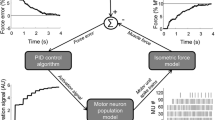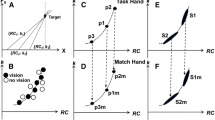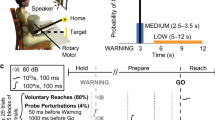Summary
In the preceding study (Gordon and Ghez 1987), we showed that accurately targeted isometric force impulses produced by human subjects are governed by a pulse height control policy. Different peak forces were achieved by modulating the rate of rise of force while force rise time was maintained close to a constant value and independent of peak force. An early measure of the rate of rise of force, peak d2F/dt2, was scaled to the required force (target amplitude) and highly predictive of the peak force achieved. In six subjects examined, peak d2F/dt2 accounted for between 70% and 96% of the total variance in peak force. In the present study, we further examined these targeted responses to determine whether the residual variability not predicted by peak d2F/dt2 could be accounted for by adjustments to the force trajectories which compensated for initial errors in the scaling of the d2F/dt2. A statistical model of the determinants of peak force was tested. This model included two paths by which the target amplitude could independently influence the peak force achieved. The first path was preprogrammed pulse height control. In this path, target amplitude determined the initial rate of rise of force (peak d2F/dt2) which in turn determined the final peak force achieved. The second path was an independent influence of errors in the initial scaling of peak d2F/dt2 on peak force. Multiple regression analysis was performed on trajectory variables within the sets of responses by each subject in each condition to determine whether the second path contributed significantly to explaining the variance in peak force. In each subject and condition, there was a significant independent influence of error in d2F/dt2 on peak force, and the direction of this effect was to decrease the magnitudes of peak force errors. These compensatory adjustments accounted for between 1% and 14% of the total variance in peak force. Further multiple regression analyses revealed that inappropriate scaling of the initial phase of the trajectories was compensated for by shortening or prolonging the force rise time. These trajectory adjustments were in turn implemented by modulation of the timing and magnitude of the contractions in the agonist and antagonist muscles that produced the force trajectories. Because these compensatory adjustments were evident in the EMG pattern at latencies too short to be accounted for by peripheral feedback, we assume that they depend on internal monitoring of the unfolding neural commands. These internal feedback processes act in parallel with the programmed commands, both determining the force trajectory.
Similar content being viewed by others
References
Alstermark B, Lundberg A, Norrsell U, Sybirska E (1981) Integration in descending motor pathways controlling the forelimb in the cat. 9. Differential behavioral defects after spinal cord lesions interrupting defined pathways. Exp Brain Res 42: 299–318
Brooks VB (1974) Some examples of programmed limb movements. Brain Res 71: 299–308
Cooke JD, Diggles VA (1984) Rapid error correction during human arm movements: evidence for central monitoring. J Mot Behav 16: 348–363
Craik KJW (1948) Theory of the human operator in control systems: II. Man as an element in a control system. Br J Psychol 38: 142–148
Desmedt JE, Godaux E (1978) Ballistic skilled movements: load compensation and patterning of the motor commands. In: Desmedt JE (ed) Progress in clinical neurophysiology, Vol 4. Cerebral motor control in man: long loop mechanisms. Karger, Basel, pp 21–55
Evarts EV (1971) Feedback and corollary discharge: a merging of the concepts. Neurosci Res Prog Bull 9(1): 86–112
Georgopolous AP, Kalaska JP, Massey JT (1981) Spatial trajectories and reaction times of aimed movements: effects of practice, uncertainty, and change in target location. J Neurophysiol 46: 725–743
Ghez C (1979) Contribution of central programs to rapid limb movement in the cat. In: Asanuma H, Wilson V (eds) Integration in the nervous system. Igaku-Shoin, Tokyo, pp 305–319
Ghez C, Gordon J (1987) Trajectory control in targeted force impulses. I. Role of opposing muscles. Exp Brain Res 67: 225–240
Gordon J (1985) Mechanisms contributing to accuracy in aimed force impulses of human subjects. Doctoral dissertation. Columbia University, Teachers College
Gordon J, Ghez C (1985) Mechanisms contributing to accuracy in aimed force impulses: rise time regulation and corrective adjustments. Soc Neurosci Abstr 11: 75
Gordon J, Ghez C (1987) Trajectory control in targeted force impulses. II. Pulse height control. Exp Brain Res 67: 241–252
Hening W, Vicario D, Ghez C (1983) Choice reaction time conditions alter response dynamics in an isometric tracking task in humans. Soc Neurosci Abstr 9: 1031
Higgins JR, Angel RW (1970) Correction of tracking errors without sensory feedback. J Exp Psychol 84: 412–416
Lundberg A (1979) Integration in a propriospinal motor centre controlling the forelimb in the cat. In: Asanuma H, Wilson V (eds) Integration in the nervous system. Igaku-Shoin, Tokyo, pp 47–64
Megaw ED (1974) Possible modification to a rapid on-going programmed manual response. Brain Res 71: 425–441
Pedhazur EJ (1982) Multiple regression in behavioral research (2nd edn). Holt Rinehart Winston, New York
Poulton EC (1981) Human manual control. In: Brooks VB (ed) Handbook of physiology, Sect 1. The nervous system, Vol 2: Motor control. American Physiological Society, Bethesda, pp 1337–1389
Taylor FV, Birmingham HP (1948) Studies of tracking behavior. II. The acceleration pattern of quick manual corrective responses. J Exp Psychol 38: 783–795
Vicario DS, Ghez C (1984) The control of rapid limb movement in the cat. IV. Updating of ongoing isometric responses. Exp Brain Res 55: 134–144
Welford AT (1952) The psychological refractory period and the timing of high-speed performance. A review and a theory. Brit J Psychol 43: 2–19
Woodworth RS (1899) The accuracy of voluntary movement. Psychol Rev 3 (2, Suppl 13): 1–114
Author information
Authors and Affiliations
Rights and permissions
About this article
Cite this article
Gordon, J., Ghez, C. Trajectory control in targeted force impulses. Exp Brain Res 67, 253–269 (1987). https://doi.org/10.1007/BF00248547
Received:
Accepted:
Issue Date:
DOI: https://doi.org/10.1007/BF00248547




